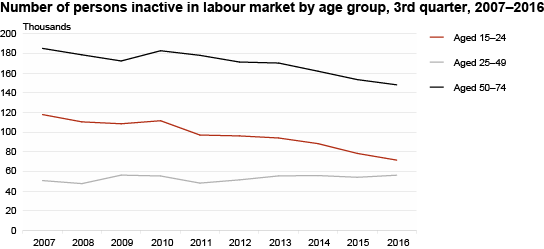The number of persons active in the labour market continued increasing
The unemployment rate increased by 2.3 percentage points compared to the 3rd quarter of 2015 and by 1 percentage point compared to the 2nd quarter of 2016 (the unemployment rate was 6.5% in the 2nd quarter of 2016). The number of unemployed persons in the 3rd quarter of this year was estimated at 53,000, with about a half of them having been unemployed for less than 6 months. The increase in the number of unemployed people is mainly due to a decrease in the number of persons inactive in the labour market, which might have been significantly influenced by the Work Ability Reform launched in 2016.
The labour force participation rate, i.e. the share of the labour force in the population aged 15–74 increased by 1 percentage point compared to the 3rd quarter of the previous year, indicating that approximately 9,000 more persons had entered the labour market. The indicator has increased the most for 15–24-year-olds – approximately 3,000 young persons have entered the labour market in a year.
The labour force participation rate has increased both for males and females. While the labour force participation rate for females was 66.4% in the 3rd quarter of 2015, the indicator was 0.8 percentage points higher in the same quarter of 2016. The indicator for males of the same age group stood at 75.7% in the 3rd quarter of the previous year and at 77% in the 3rd quarter of 2016.
The increase of the labour force participation rate has been faster in rural areas than in urban areas – while, compared to the 3rd quarter of the previous year, the activity rate has increased by 2.4 percentage points in rural areas, then in urban areas by 0.4 percentage points.
The estimated number of employed persons was 653,000 in the 3rd quarter of this year. The employment rate fell by 0.7 percentage points compared to the 3rd quarter of 2015 and by 0.4 percentage points compared to the 2nd quarter of 2016. While the employment rate of 15–74-year-old females was 62.6% in the 3rd quarter of 2015, the indicator had decreased by 0.5 percentage points by the same quarter of 2016. There has also been a slight fall in the indicator of males of the same age group – while the employment rate of working-age males was 72.2% in the 3rd quarter of the previous year, it was 71.2% in 3rd quarter of the current year.
The number of persons inactive in the labour market has been decreasing steadily in 2016 – compared to the 3rd quarter of 2015, the number has declined by about 10,000. There has been a remarkable fall in the number of inactive persons aged 50–74 – compared to the 3rd quarter of the previous year, approximately 5,000 persons belonging to this group have entered the labour market. Most of them (about 3,000) were female and this might have been due to the rise in the pensionable age of females.
Although the main reasons for being inactive in the labour market are still retirement, ongoing studies and an illness or disability, the decrease in the number of inactive persons has been mainly on the account of people who are inactive due to those reasons.The unemployment rate is the share of the unemployed in the labour force (the sum of employed and unemployed persons). The employment rate is the share of the employed in the working-age population (aged 15–74). The labour force participation rate shows the share of the labour force in the population aged 15–74. The estimates are based on the data of the Labour Force Survey.
Statistics Estonia has been conducting the Labour Force Survey since 1995 and every quarter 5,000 persons participate in the survey. The Labour Force Survey is carried out by statistical organisations in all the European Union Member States on the basis of a harmonised methodology.